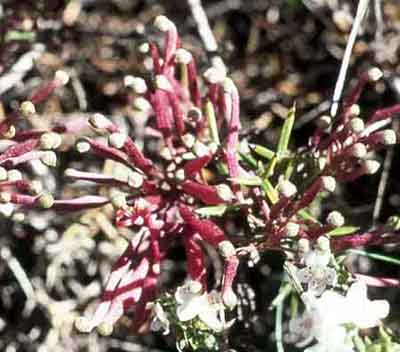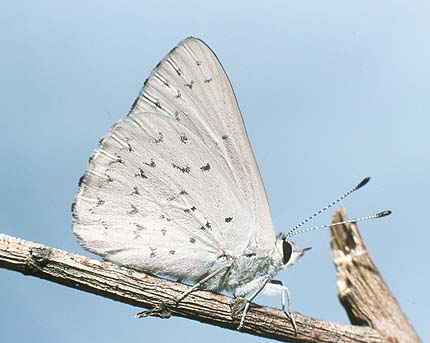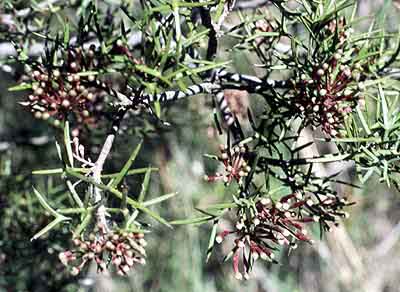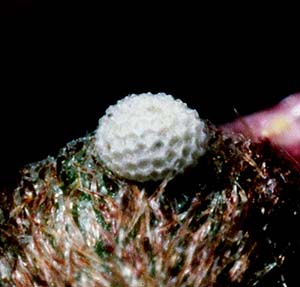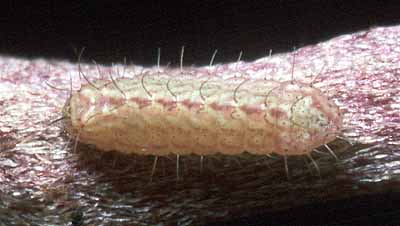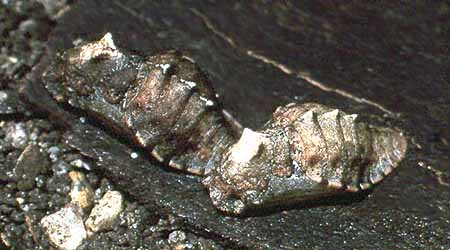-
Larval Food Host
-
In South Australia it utilises plants belonging to the Proteaceae family. In temperate areas
its primary larval hostplant is the red flowered Grevillea huegelii
(comb grevillea) (Proteaceae). If the latter is absent then it will utilise
Hakea leucoptera (needle bush) (Proteaceae).
Recently (2011) in the Yumbarra Conservation Park it was found to utilise
G. pterosperma (desert grevillea) and
G. sarissa ssp umbellifera (desert comb-grevillea).
The former is a tree grevillea with white flowers, while the latter is similar to
G. huegelii but has much larger leaves. It probably utilises other Grevillea
and Hakea species like H. mitchellii (desert hakea) as the butterfly can occur
in areas where the known hostplants are absent.
The butterfly was also recently found flying in the Northern Territory, adjacent
to the Far-northwest Region of South Australia. Hostplants were not identified
but Grevillea juncifolia was considered a possible candidate as it was
flowering at the time, although the stickiness of the flower buds may preclude
its use as a hostplant as the larvae could become trapped; seven other Proteacous
plants also occurred in the area at the time.
In the eastern states, larvae are found on Conospermum species (smoke-bushes),
Grevillea spp (Proteaceae), and Jacksonia scoparia (dogwood) (Fabaceae).
Early stages have yet to be found on Conospermum in South Australia.
The larvae feed on the flowers or soft new growth of the hostplants. In captivity
the larvae will eat the flowers of most species of Grevillea and Hakea.
-
Larval Attendant Ant
-
Attended by small black or dark brown and black ants,
usually Iridomyrmex species.
-
Eggs
-
Small, initially pale green, later turning bluish, hemispherical, top rounded,
base flattened, with a coarsely reticulated, strongly raised pattern which is
continuous to the micropylar area, and with very slight blunt projections at
the pattern intersections. The reticulations are irregular, consisting of shapes
varying from quadrangular to hexagonal. Laid singly on the hostplant.
On Grevillea huegelii they are laid at the end of newly formed flower buds,
and only on those plants on which small black ants occur.
The eggs hatch in about one week.
-
Larvae
-
The first instar is pale greenish yellow, later becoming pink after eating the red flowers
of the hostplant. There are long lateral and posterior setae, and long recurved dorsal setae.
Later instars are onisciform (slater shaped), and develop dorsal and lateral tubercles bearing
black bristly hairs (setae). These tubercles become progressively better developed with
successive instars. The long setae are lost by the third instar.
The final instar is about 20 mm long. Onisciform shape, with well developed, soft, bristly
tubercles being present dorsally and laterally. They occur in dorsal pairs on the first
three anterior body segments, followed by another eight single dorsal tubercles. There is
a single tubercle on each segment laterally, the one present near the posterior end being
significantly extended. The body is covered in numerous minute secondary setae, which are
curved spinose and slightly serrated, while the base is simple and ridged. The head is small,
smooth, brownish yellow, hidden beneath the body. Colour and markings are
highly variable, and very picturesque. The pattern
is of the usual Lycaenid type with a longitudinal dark dorsal line, a wide dorsal apron edged
with inward directed dark chevrons, and a further series of chevron patterns along the side,
and finally a pale lateral line. The overall colours usually blend in with the portion of the
hostplant they are eating, such as mostly red or purple or orange or pale grey or whitish if
they are eating like coloured flowers, or green or yellowish if they are eating leaves.
In captivity the colour can change several times during the life of the larva, especially if
the hostplant is changed between different coloured flowers or leaves. Near the point of pupation
the larval colour fades and the larger tubercles change colour to brilliant turquoise.
The camouflage of the larvae on their hostplants is excellent and it is very difficult to observe
them in the wild. The larval biology is unusual for a butterfly in that it is capable of completing
its larval period in only four instars. (Lycaenids normally require five instars).
In captivity the larva period takes 4-6 weeks to complete.
-
Pupae
-
Have a shape typical for the Candalides tribe, about 14 mm long, roughly triangular
in cross-section, and having a well-developed abdominal saw-tooth dorsal ridge with short
blunt spines. A divided blunt dorsal projection occurs on the thorax. The lateral part of
the abdomen and anterior edge of the head is flattened, with the head flange divided at the
front. It is cryptically marked brown and grey. The dorsal bifid projection is white, the
dorsal abdominal spines are white tipped, the wing cases are grey, and there is a pair of
black spots dorsally above the head. Attached by the cremaster and a central girdle. Pupae
have not been found in the wild in South Australia. The pupae are known to stridulate, making
a series of audible clicks, which are believed to be used to send messages to attendant ants.
In captivity the pupal duration is extremely variable. It can be as short as 24 days, but it
more usually lasts a full year, with the butterfly emerging the following season. However,
some pupae diapause (remain dormant) for much longer, with records up to about 36 months.
Limited experimentation with pupae in captivity indicates that dormancy is broken primarily
by the flowering of its hostplants that normally occurs in spring.
-
Flight Period in South Australia
-
Normally mid-September to mid-December, with the flight starting earlier in the northern hotter
areas of its range. It is believed to have only one brood a year in South Australia, although
specimens in captivity have completed their life cycle in 9 weeks and have emerged at other
times than above, suggesting that more than one brood may be possible if the climatic conditions
are suitable. An autumn brood occurs in Queensland.

-
Distribution
-
In South Australia the butterfly has usually been found in the southern mainland parts of
the state, wherever its presently known hostplants occur in sufficient density. Based on
the distribution of its larva hostplants, the butterfly is likely to be more extensive
than its present known range. It has yet to be found in the forests of the Lower Southeast
but may eventually be found in that region in the low woodlands along the coast or along
some of the limestone-terrarossa ridges. The butterfly was recently recorded in the southwest
of the Northern Territory, just across the border from South Australia, and some 800 km from
its previous, closest known distribution point. Also recorded from southwest Western Australia
and western Victoria, and also coastally and along the Great Dividing Range in NSW and southern
Queensland. A separate subspecies occurs in southern Queensland.
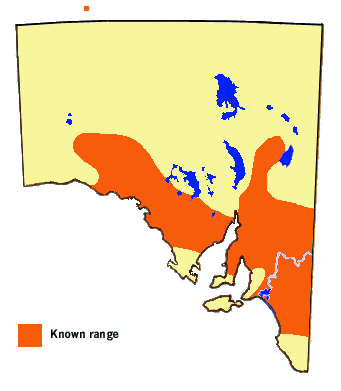
-
Habitat
-
It occurs mainly in open mallee (low rainfall eucalypt) habitat, but also in higher rainfall
shrubland/heathland. The butterfly favours the more pristine habitats of its hostplants,
which are widespread and locally common. The Grevillea huegelii occurs on the heavy
red soils of the inter-dune areas, whereas the Hakea and some other Grevillea
species hostplants prefer the sandy soils on the dunes.
-
Conservation Status in South Australia
-
Considered to be a rare butterfly, males are more often encountered than females.
-
Threats
-
Its mallee habitat is still widespread. The butterfly is only threatened in areas of
urbanisation and agricultural disturbances. Now extinct in the Adelaide region. Its
hostplants are not normally grazed due either to their inedible properties or very
prickly leaves.
-
Conservation Strategy
-
None required at this point in time, so long as there is no further loss of habitat.



